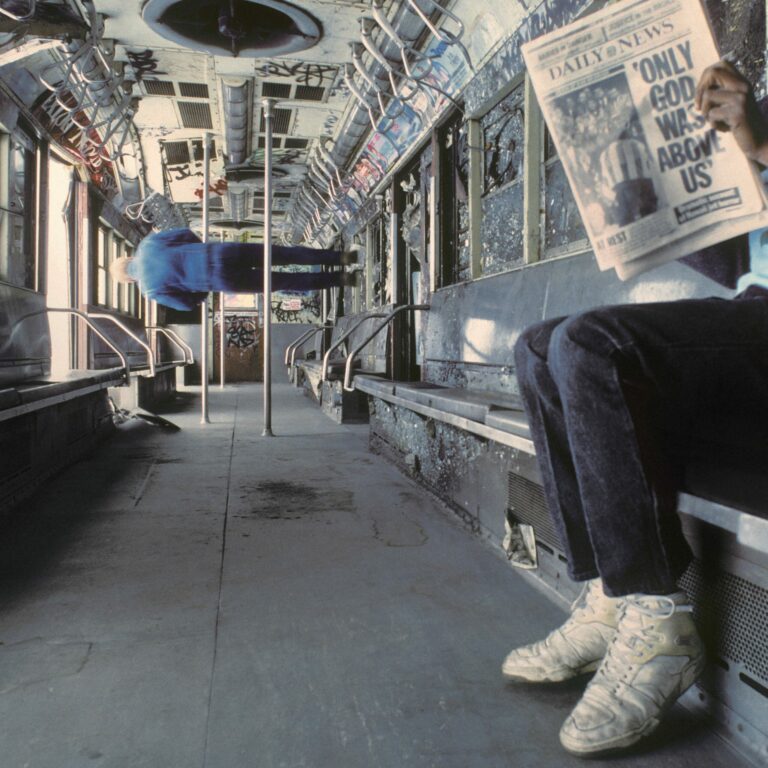Amber Mark has returned with a new single, ‘Comin’ Around Again’. It marks her first new music since the release of her debut album, Three Dimensions Deep, in January 2022. Check out a visual for it below.
Phosphorescent on How the Rivers in Nashville, Real Magic, and Downer Music Inspired His New Album ‘Revelator’
“I got tired of sadness/ I got tired of all the madness,” Matthew Houck sings at the beginning of Revelator, his first Phosphorescent album since 2018’s C’est La Vie. It’s a killer opening line in part because it signals a fresh start, when really it ends up feeling like a grand return: Houck getting back down to the core of what so much of Phosphorescent’s discography has been about, only this time from a renewed vantage point. In the years between 2013’s Muchacho and C’es La Vie, Houck had two children with his wife, the Australian musician Jo Schornikow – who wrote Revelator‘s ‘The World Is Ending’, the first Phosphorescent song to be written by an outside artist – moved from New York to Nashville, and faced a life-threatening bout of meningitis. In 2022, he released The Full Moon Project, a collection of a dozen covers he had been rolling out each month. Though it only took him about six months to write and record Revelator, tuning into the flow of his own songs wasn’t easy. The song after which he named the LP was the north star. He enlisted collaborators such as Jack Lawrence of the Raconteurs and Jim White of Dirty Three, but a lot of time was spent alone, trying to get things right at the studio he’s built at home, dubbed Spirit Sounds. It’s hard to do, as Houck sings over and over on the final track, but the process proved constantly revelatory.
We caught up with Matthew Houck to talk about some of the inspirations behind Revelator, which is out today, including the rivers in Nashville, his studio Spirit Sounds, the title song, and more.
The rivers around and running through Nashville
This is the kind of imagery I immediately associated with Revelator, because you announced it with that press photo and the video for the title track, where you sing the song while rowing down a river.
I’m glad that was successful as a thing, because I do think I haven’t done that much in the past, with marrying these records with the visual part of the world – not even just visual, but also the sort of realm. This album feels like a river to me. Obviously, a lot of it was because I was going out to those rivers to sit and write. That was just the place that I found was a good place to go, I could get out there fairly quickly. I was looking for swimming pools, to be honest, but I didn’t have all that much luck with finding places to actually swim; I just found a lot of little spots by rivers. I think it naturally affected some of the imagery and some of the language, but then what really happened later was that sonically, it just felt very flowy and rivery – I don’t mean to say smooth, because it’s just got a real motion to it that I think is like floating.
It also feels dark, and those rivery colours feel correct. The image on the album cover was a painting that I was lucky enough to find right at the time when it was time to figure out what album cover was going to look like, and it just slotted in perfectly. It’s not a river, but it’s the way the clouds in the sky are, and the way that there’s a foreboding quality to it all – a little bit of an unsettled feeling is very much how I see the world of this record.
What attracts you to going out there to write? What did that free up in your mind?
This studio is just a windowless, big room, and I love it, but I miss nature. I lived in New York City, and somehow, even there I got more nature than I somehow get in Nashville. I don’t know why that is really. Very close to outside of town, there’s all the nature you can handle, but for whatever reason – I think it was because I was building this studio out and was just in here a lot, and I needed some other feeling to start writing. What I find though, weirdly, I don’t feel like I’m ever successful when I actually go out and sit with a notebook or a guitar even – you do it, and nothing really happens. It’s weird – nothing happens then, but later, maybe the next day, it has done something. It’s unblocked something. Maybe there’s a delay on how my brain works.
You mentioned having that realization that the record flowed like a river. Did that then also become a goal for you, or were you done with recording by that point?
Nope, you’re absolutely right. Specifically the song ‘Revelator’, the thematic, lyrical stuff that was going on there, and also the sound, it very much influenced the process of where I went with the other ones. At a certain point, you set a thing in motion, you put out your antennas, and it can just start happening. You’ve got all the vessels in place, and ideally you just hold on a little bit and try to see where the songs are taking you. You’re not trying to push them into some place, they kind of pull you along. To be honest, that’s generally where I feel I’m doing something right, when that starts happening and you feel like you’re being sucked along by the momentum of the thing. That always feels like a sign that I’m doing the right thing.
Since we’re on the topic of nature, there’s a sense of dread, even specifically environmental dread, that pervades the album, and I’m curious if being in nature amplifies those feelings or actually removes you from them.
I feel like it removes them. I think I’m learning in my life that I am much more of a nature person than I would have thought. There’s always this thing about the intention of something – you state something and then you do that thing, and I’ve never really operated like that. I feel like I don’t know these things until it’s happening, and all of a sudden you realize you’re a much happier person when I’ve been swimming all day as opposed to the person that I’m sitting in here twiddling knobs – as much as I love making music, don’t get me wrong. The making of records, you can’t do it out – or maybe I’ll try to do that, in a field or something. But it’s very amps and guitars and guitar pedals, that’s all a very different world, and I live in that world a lot. And I think even the inward world of writing songs and looking inward all the time, being inside this body and this mind, I’d love to be free of all that and instead be in the ocean.
His studio Spirit Sounds
You built the studio after moving to Nashville to record C’est La Vie, which obviously a painstaking process. What effect did working in this space, and not having to go through all apart from maintaining it, have on the making of Revelator?
It was delightful. Having your own studio, there’s always little problems, things break, but not at all in the way that it was making C’est La Vie, which was a really tough thing, not having the place built quite yet and dealing with a bunch of stuff. I’ve worked in other studios, and I feel like I need to have the freedom of my own space and also solitude. It turns out I need to be alone, messing with microphones and trying to feel out the vibe. I haven’t been able to really access that part of the creative process when there’s three engineers and like an assistant, there’s just people around and you’re on a clock, you have a real schedule where you’ve booked x amount of hours and you go there for those hours. And you better hope that your mood is correct, which I find is another thing that I don’t have a great amount of control over, getting into the mood of making music. It seems to be something that’s a little bit elusive still for me. I can get there eventually, but it takes me a little longer to strike on the path of what I think is good. I generally feel like I need the time to just fuck around, honestly, and make mistakes. So having this space, for better or worse, is the reason that Phosphorescent records sound like they do and are what they are. I don’t know that I’d be able to make them in another way.
Do you feel like you have to impose some limitations on ourself to make it work?
Well, limitations get imposed, whether from the self or not. I do keep more regular hours as a human than I did for years. I’ve got kids now, so you end up having a different schedule of life, and adapting to that is a different thing. There’s limitations in time, there’s limitations in your energy. And I also do actually really like musical and technical limitations. Even though I do use a computer, I tend to treat it like a tape machine, I don’t go wild with hundreds of tracks and endless stuff. So, I had these four players over for only four sessions, it turned out, to record the core framework of what this was gonna be. And later, of course, I did mess with it forever, like five, six months, but the initial creative thrust of it was to try to get these four players in and myself and just roll tape immediately when showing them the songs. No one knew them yet, but they’re all great players, and just recorded live in this room. Probably maximum would have been four takes of any given song. There’s some real magic that happens right then, and you have to be ready to capture it, because in my experience you can’t go backwards from that initial instinctual inspiration of playing something for the first time, feeling it out. Because inevitably, you rehearse too much and things get stale really quickly, and you can lose that initial spark.
The song ‘Revelator’
You’ve said that this is the song is the one that made you realize you were writing an album. What feelings came along with that realization?
I played that song through for a friend when it was it was finished, and that’s always a pretty weird moment. I don’t do that very often before going ahead and trying to record it. But this one, I was a little unclear about what I was doing, and playing it out loud for the first time, it all of a sudden was a moving moment. And they were very complimentary about it. I struggle with uncertainty a lot, I don’t have bulletproof confidence in all this stuff – until I do know, and then I can summon that confidence. But in the beginning, it’s all such a fragile thing and so uncertain and so unclear. Once I knew that song was the song that I thought it was, it set the tone for the record, and the other songs, which had a lot of thematic stuff that wasn’t finished yet, came together pretty quickly. I was able to really write the rest of those songs and finish them, and it started looking like an album pretty quickly to me.
You were also uncertain about titling the album Revelator. What made you stick to it?
It’s just so clearly the – theme feels weird to say, but it might be that. It feels like the north star of what I was following to make it, but also the north star of what this record is. It’s a revelator to me as well to look at these songs; it calls question some stuff for me in my life. Frankly, I look at the record and I have to wonder if I’m, you know, an unhappy person. I don’t think that I am, but I might be. There’s a lot of really heavy material, and it’s a revelatory thing. You’re always revealing yourself to yourself, maybe, and trying to understand what is being revealed.
Trusting in somber, downer music
Part of what resonated with me about the record is that it doesn’t feel like a heavy record – there’s a lightness to it and the sort of contentment that comes with being at an ideal place in your life. But it’s also able to carry anxiety and sadness without being totally unsettled by those feelings.
That great to hear, and that’s my hope. And I know that’s what music does, I know that’s what sad songs do, and I trust that. The art and music in my life has always tended toward darker and sadder stuff, because it does do the opposite somehow. Not sad, defeated stuff, but more just facing up to it: let’s address the looming darkness in this world and not be not be afraid of it. Hopefully, that does ultimately make something that makes you feel stronger and lighter. I do trust and hope that that’s what it does.
Have there been points where consuming or making that kind of music felt detrimental or wrong, in some way?
You’re hitting the nail directly on the head with that. Here’s an anecdote that might describe it. It’s an album, right? There’s songwriting going on, there’s the sound of the music, there’s the production, a setting and a mood gets made. All that stuff comes into play, and I do think the end result is what we’re talking about. That being said, over the past couple weeks, they’ve been sending me out to play a few solo songs at a radio station, just me and a guitar, and like, at 11am in a brightly lit radio station, some of these songs sound insane. [laughs] It can easily call into question what the fuck am I doing. It’s okay, I think, to put it in front of those kinds of things, but there are moments where I do question in a very frank way, is this music working? Or is it like listening to somebody moan at 11am on a Tuesday?
And maybe it has a different effect if I’m replaying that recording in a darkly lit room at night. It’s interesting in the context of the first lines on the record: “I get tired of sadness/ I get tired of all the madness.” In that moment, it almost feels like a promise that you’re setting away all that, when the rest of the album still contains it. How conscious were you of highlighting and capturing the beauty in it?
Yeah, that was a real moment with this album. Like I was saying about it taking the reins, I started this album with those initial sessions and I was keeping, in a sonic sense, a really – not distant, but small record. It wasn’t a welcoming record to listen to when I first started. I was burying the vocals under a lot of layers and kind of making it uneasy to listen to. I was thinking of it as a very personal and small record that maybe was going to be very stripped down and stark. And through the process of it, it started revealing itself as this thing that could be really grand and welcoming, in spite of that initial feeling of worry and dread, so then it just became a process of following what that is.
It started with these early sessions, then I worked on it for like six months and got to where I was like, “I think it’s almost finished.” I ended up getting in touch with this mixer named Dave Cerminara, who’s great. I had never worked with him, but I knew of him, and we went to [Sunset Sound in] Los Angeles and put it through a big, famous old console and ran it to tape. The record was about 90% done, but there was a 10% that, even then, it continued to reveal itself as, like, “These aren’t the small songs that I thought they were. They feel like big, beautiful, breathing things.”
To be honest, it became a thing where it also just fucking jams, turning it up on the big speakers in there. Where I had it, it sounded really nice, but it was all kind of in your head. Dave is agreat engineer and mixer, and all of a sudden it’s like, these drums don’t have to be in your head. You feel them in your chest and your heart; you feel the drums, you feel the bass. There’s a real physicality to the music that I think I was not achieving, and I wasn’t even particularly aiming for. That was a real revelatory thing. I was just really thrilled at how fucking pretty this record sounds, how big and muscly. Whatever concerns I might have about what it is, I know for a fact it’s a great-sounding record. [laughs]
Real magic
You talked about real magic in the context of those sessions, but I’m aslo reminded of the song ‘A Moon Behind the Clouds, where you sing: “I’d tell you bout a feeling/ But I lose it in a crowd/ The stars beyond the ceiling/ A moon behind the clouds.” To me, that feeling a magical because it’s so hard to grasp or articulate. Is that in line with what you’re referring to?
Absolutely, yeah. Lyrically, that’s a great place to point at, and I love that that song reached you. That’s how I feel about that bit as well. It’s like I was saying about going out to the river to write – sometimes when you’re doing that, it often feels like nothing’s happening, and that can be discouraging. But you just do it anyways, and that’s where I feel like what you’re actually doing is you’re pushing out these antennas through sheer effort – that’s the part that feels like it’s work – and all of a sudden things do just start dropping into place. And I forget this every time, so maybe that’s why I’m writing it down and saying it’s an inspiration for this record. I’ve literally forgotten that and remembered that a thousand times in my life at this point, and maybe that’s just me – I feel it’s very easy to feel a little bereft and a little jaded, and I don’t want to be a jaded person. So I’m always remembering that in fact, it’s not abandoned you, and there is real beauty and real magic in this world, and you might not be able to touch it all the time, but it doesn’t mean that it’s gone. You just gotta realign yourself so that you can receive it, because it’s there.
The magic is there, but it’s almost like the belief has to be renewed every time. Do you find that you’ve developed different tools to tap into it?
I’ve been making these Phosphorescent records for a lot of years now, and I do still think that each one has been better than the one before it. People might disagree or whatever, and obviously one day I’ll probably, surely get to a point where I’ll have to say, “Well, this one wasn’t as good as the one before it.” But I’m not there yet, and I do feel like the body of work has been kind of aiming at the same thing over and over all, but you’re right, you have different tools, you have a different perspective, and I guess at some point you’re not the same person, once enough of those things compile. But I do feel very much that it’s a continuous thing. I enjoy the process of making stuff and wanting to get better at it, believing that it’s a worthwhile endeavor.
Is it easier to trust that process now, even if you’re tackling similar themes and there’s a certain level of uncertainty?
No. [laughs] Maybe after this one I can remember to absolutely trust it. But it’s one thing to know that something is true on paper, and then another thing to to be in throes of a discomfort and worry or whatever. And I think that’s just in life, like when it’s freezing cold outside, it’s like I can’t even recall what summer is. I don’t even remember. I know for a fact that it will be warm again in a number of months or whatever, but that knowledge doesn’t – you’re still freezing your ass off and wondering. [laughs] It’s hard to remember that it can be blazing hot in a number of months.
This interview has been edited and condensed for clarity and length.
Phosphorescent’s Revelator is out now via Verve/Decca Records.
J. Cole Surprise Releases New Project ‘Might Delete Later’
J. Cole has surprise-released a new project called Might Delete Later. The 12-track collection boats guest spots from Gucci Mane, Cam’ron, Bas, Central Cee, Ari Lennox, and Young Dro. Stream it below.
The record’s closing track, ‘7 Minute Drill’, appears to clap back at Kendrick Lamar’s recent guest verse on Future and Metro Boomin’s ‘Like That’, which saw him taking shots at Drake and J. Cole. “I got a phone call, they say that somebody dissing/ You want some attention, it come with extensions,” Cole raps. “He still doing shows but fell off like The Simpsons/ Your first shit was classic, your last shit was tragic/ Your second shit put n-s to sleep but they gassed it/ Your third shit was massive and that was your prime/ I was trailing right behind and I just now hit mine.”
Might Delete Later marks Cole’s first full-length release since 2021’s The Off Season. Earlier this year, the Fayetteville rapper confirmed he’s finishing up work on his next album The Fall Off.
View this post on Instagram
Albums Out Today: Vampire Weekend, Phosphorescent, the Black Keys, Mount Kimbie, and More
In this segment, we showcase the most notable albums out each week. Here are the albums out on April 5, 2024:
Vampire Weekend, Only God Was Above Us
- Listen / Buy
- TIDAL
- Spotify
- Apple Music
- Physical

Phosphorescent, Revelator
- Listen / Buy
- Bandcamp
- Spotify
- Apple Music
- Physical

The Black Keys, Ohio Players
- Listen / Buy
- Bandcamp
- Spotify
- Apple Music
- Physical

Mount Kimbie, The Sunset Violent
- Listen / Buy
- Bandcamp
- Spotify
- Apple Music
- Physical

Still Corners, Dream Talk
- Listen / Buy
- Bandcamp
- Spotify
- Apple Music
- Physical

Drahla, angeltape
- Listen / Buy
- Bandcamp
- Spotify
- Apple Music
- Physical

Fabiana Palladino, Fabiana Palladino
- Listen / Buy
- Bandcamp
- Spotify
- Apple Music
- Physical

Bnny, One Million Love Songs
- Listen / Buy
- Bandcamp
- Spotify
- Apple Music
- Physical

Khruangbin, A la Sala
- Listen / Buy
- Bandcamp
- Spotify
- Apple Music
- Physical

The Libertines, All Quiet on the Eastern Esplanade
- Listen / Buy
- TIDAL
- Spotify
- Apple Music
- Physical

Dana Gavanski, Late Slap
- Listen / Buy
- Bandcamp
- Spotify
- Apple Music
- Physical

Lillie West, if i were a real man i would be able to break the neck of a suffering bird
- Listen / Buy
- Bandcamp
- Spotify
- Apple Music
- Physical

Other albums out today:
Conan Gray, FOUND HEAVEN; Lizzy McAlpine, Older; Jane Weaver, Love in Constant Spectacle; Vegyn, The Road to Hell Is Paved With Good Intentions; The KVB, Tremors; Grace Cummings, Ramona; Gustaf, Package Pt. 2; Bob Vylan, Humble As the Sun; Sinkane, We Belong; RiTchie, Triple Digits; Adam Wiltzie, Eleven Fugues for Sodium Pentothal; The Bygones, The Bygones; Joseph Shabason, Nicholas Krgovich, and M. Sage, Shabason, Krgovich, Sage; Caleb Landry Jones, Hey Gary, Hey Dawn; Maxband, Maxband on Ice; Katie Pruitt, Mantras; Vessel, Wrapped in Cellophane; Feeder, Black/Red; Marcus King, Mood Swings; Beatenberg, The Great Fire of Beatenberg; Lo Moon, I Wish You Way More Than Luck; Flung, All Heartbeat; Cuffed Up, All You Got; Motel Breakfast, I Promise I’m Having Fun; Olin Janusz, Please Leave Quietly; Annie-Claude Deschênes, LES MANIÈRES DE TABLE; FYEAR, FYEAR; Guests, I wish I was special; Coral Morphologic and Nick León, Projections of a Coral City.
Sis Announces New Album ‘Vibhuti’, Shares New Single
Sis has announced a new album called Vibhuti. Due out June 21 via Native Cat, it includes the previously released single ‘Center of the Heart’, and Jenny Mason has today shared a new track, ‘Mother’s Grace’. Check it out below.
“This song started out very quiet in terms of sonic elements, which mirrored my intention — I wanted to write about the concept of asking for the grace of the Divine Mother in my life,” Mason explained in a statement. “More specifically, I was finding new inroads with my speech, to take a pause and ask for help before I said something in a difficult situation. Or as Sri Aurobindo writes, ‘When I speak, the reason says, This will I say; but God takes the word out of my mouth and the lips say something else at which reason trembles.’ Then as the percussive layers were built, I felt it was going more towards a joyful, revival kind of sound that was mirroring the building of joy and strength in my own life at that time.”
Vibhuti draws inspiration from the works of 20th century Indian mystic Sri Aurobindo and his partner, the Mother. It features longtime collaborators Brijean and Doug Stuart on percussion, bass and production, and Will Miller of Resavoir on trumpet and Devendra Banhart on electric guitar.
Read our Artist Spotlight interview with Sis.
Vibhuti Cover Artwork:
Vibhuti Tracklist:
1. Cave of Plenty
2. Mother’s Grace
3. Bow To Your Wilderness
4. Splendor
5. Jugaspa
6. Pregnant in Bhutan
7. Center of the Heart
8. Rose Gold Shoes
9. Mystic Spider
10. Stargate Road
Orville Peck and Willie Nelson Cover Ned Sublette’s ‘Cowboys Are Frequently Secretly Fond of Each Other’
Orville Peck has teamed up with Willie Nelson for a cover of Ned Sublette’s 1981 song ‘Cowboys Are Frequently Secretly Fond of Each Other’. It marks Peck’s first release since signing with Warner Records and will appear on an upcoming duets collection called Stampede. Check it out via the Ben Prince-directed video below.
Peck’s last LP was 2022’s Bronco. Nelson’s 75th album, The Border, is set for release on May 31.
Doja Cat Releases ‘Scarlet 2: Claude’ Featuring Seven New Songs
Doja Cat has released the deluxe edition of her fourth album, Scarlet, which came out last September. It features seven new tracks: ‘Piss’, ‘Urrrge!!!!!!!!!!’ with A$AP Rocky, ‘Okloser’, ‘Disrespectful’, ‘Masc’ featuring Teezo Touchdown, ‘Headhigh’, and ‘Acknowledge Me’. ‘MASC’ also comes with a music video directed and shot in Los Angeles by Doja Cat and Jamal Peters. Take a listen below.
Chappell Roan Releases New Song ‘Good Luck, Babe!’
Chappell Roan has released a new song called ‘Good Luck, Babe!’. It’s her first new music since her 2023 debut The Rise and Fall of a Midwest Princess and marks the beginning of a “new chapter,” according to Roan, who said the song is about “about wishing good luck to someone who is denying fate.” Check out a lyric video for it below.
Groove and Green: How THC Enhances Musical Experiences
The dance between cannabis and music spans decades, creating unique experiences that resonate deeply with those who partake. This exploration looks at the nuanced relationship between THC, the principal psychoactive component of cannabis, and the auditory delight of music.
The Science and Personal Echoes
THC’s Interplay with the Endocannabinoid System and Brain Responses
At the core of this intriguing interplay is our body’s endocannabinoid system (ECS), a complex network ensuring internal balance. THC’s interaction with this system, especially the CB1 receptors in the brain, might trigger a series of notable effects. The potential for altered perception stands out, with THC possibly transforming sensory experiences to make sounds more vivid and immersive. Moreover, the mood-elevating properties of THC sometimes deepen our emotional connection to music, while its influence on time perception may allow for a prolonged, more engrossing musical engagement.
Diving deeper, research points to THC’s impact on brain regions critical for sound processing and music appreciation. This influence could lead to an increased sensitivity to musical details and a heightened sense of pleasure derived from music, sometimes manifesting as “music-induced chills.” Yet, the complexity of these interactions underscores the need for further research to unravel the full scope of THC’s effect on our musical experiences.
Beyond scientific studies, personal anecdotes from musicians and listeners alike paint a vivid picture of the enhanced sensory journey facilitated by music and THC. Reports often highlight an amplified auditory experience where music’s subtleties become more pronounced, leading to a deeper emotional engagement with the soundscape.
The Creative Symbiosis: Artists, Strains, and Soundscapes
The history of cannabis and creativity is rich, with legends like Bob Marley and Jimi Hendrix weaving cannabis into their musical narratives. This tradition continues today, suggesting an enduring bond between artistic expression and THC.
The interplay between specific cannabis strains and musical genres adds another layer of complexity to this relationship. Sativa strains, known for their uplifting effects, may complement creative genres like jazz or psychedelic rock, while the calming nature of indica strains seems to align with more mellow sounds, such as blues or soul music. Hybrid strains, blending sativas and indicas, offer a versatile auditory experience adaptable to various musical styles.
Legal Considerations and Enhancing the Musical Experience
Music Venues and Cannabis Regulations
The legal context of cannabis use, particularly at public music events, presents a maze of challenges. Variations in local laws necessitate a keen awareness of the rules governing public consumption, age restrictions, and the sale of cannabis at music venues.
Recommendations for a Resonant Experience
Crafting a THC-friendly playlist can set the tone for a profound musical journey. High-quality audio equipment can further enhance this experience, making every note resonate more deeply. Engaging with the music mindfully and exploring new artists or genres can also enrich the listening experience. The choice of cannabis strain, whether sativa for its creative spark or indica for relaxation, can tailor the auditory adventure to one’s current mood or desired ambiance, complementing the experience of sipping a THC-infused drink, whether in a can or a crafted cocktail at home.
Experiencing live music under the influence of THC can elevate the concert-going experience, with the communal energy and live sound intensifying the effects of THC. Sharing these moments with friends can turn the experience into a collective journey, deepening the bond over shared musical and sensory explorations, enhanced by the communal enjoyment of THC-infused beverages, whether commercially produced or concocted at home.
In essence, the confluence of THC and music opens up a realm of heightened auditory experiences, offering a unique lens through which to engage with and appreciate music. While personal experiences with this synergy may vary, the overarching narrative points towards a transformative and enriching journey through the world of sound, guided by the subtle influence of THC, whether enjoyed in a can or in a homemade infused cocktail.
Porij Share New Song ‘Ghost’
Porij have released a new single, ‘Ghost’, the latest preview of their upcoming debut LP Teething. Listen to it below.
Teething is set for release on April 26 on Play It Again Sam. So far, it’s been previewed by the singles ‘My Only Love’ and ‘Unpredictable’.











